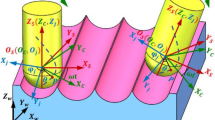Abstract
Ball-end milling cutter has a strong adaptability and widely used in machining complex surface of parts. However, the geometry of ball-end milling cutter tooth is complex, and contact points between cutter tooth and part are varying constantly during milling process, which lead that it is difficult to study the surface topography by the traditional experimental method. Based on the time-step method, this paper proposes an improved Z-MAP algorithm to simulate the part surface topography after ball-end milling. On the basis of the cutter tooth movement equation established by homogeneous matrix transformation, the improved Z-MAP algorithm combines servo rectangular encirclement and the angle summation method to quickly obtain the instantaneous swept points that belong to the part, and introduce Newton iterative method to calculate the height of swept points. Comparing to traditional Z-MAP algorithm which discrete segments of cutter tooth can only sweep one discrete point of part during a unit time step, the proposed algorithm need not to disperse cutter tooth, accomplishes higher precision and efficiency. The influence of processing parameters, such as step over, feed per tooth, cutter posture, and cutter tooth initial phase angle difference, upon the surface topography and roughness are analyzed. The experiments are conducted to validate the availability of the proposed algorithm, and the results show that surface topographies simulated by the improved Z-MAP algorithm have a higher consistency with the experiments and costs less time than by the traditional Z-MAP algorithm under the same simulation conditions. Therefore, the proposed algorithm is effective for simulating the machined surface quality in practical production and rational selection of machining parameters.
Similar content being viewed by others
References
Wang HX, Zong WJ, Sun T, Liu Q (2010) Modification of three dimensional topography of the machined KDP crystal surface using wavelet analysis method. Appl Surf Sci 256(16):5061–5068
Ait-Sadi H, Hemmouche L, Hattali L, Britah M, Iost A, Mesrati N (2015) Effect of nanosilica additive particles on both friction and wear performance of mild steel/CuSn/SnBi multimaterial system. Tribol Int 90:372–385
Imani BM, Elbestawi MA (2001) Geometric simulation of ball-end milling operations. J Manuf Sci Eng 123(2):177–184
Sadeghi MH, Haghighat H, Elbestawi MA (2003) A solid modeler based ball-end milling process simulation. Int J Adv Manuf Technol 22(11–12):775–785
Liu N, Loftus M, Whitten A (2005) Surface finish visualisation in high speed, ball nose milling applications. Int J Mach Tools Manuf 45(10):1152–1161
Liang XG, Yao ZQ (2013) Dynamic-based simulation for machined surface topography in 5-axis ball-end milling. J Mech Eng 06(6):171–178 (in china)
Xu AP, Qu YX, Li WM, Zhang DW, Tian H (2001) Generalized simulation model for milled surface topography-application to peripheral milling. Chin J Mech Eng 14(02):121–126
Hu W, Guan J, Li B, Cao Y, Yang J (2015) Influence of tool assembly error on machined surface in peripheral milling process. Procedia CIRP 27:137–142
Omar OEEK, El-Wardany T, Ng E, Elbestawi MA (2007) An improved cutting force and surface topography prediction model in end milling. Int J Mach Tools Manuf 47(7–8):1263–1275
Lavernhe S, Quinsat Y, Lartigue C (2010) Model for the prediction of 3D surface topography in 5-axis milling. Int J Adv Manuf Technol 51(9–12):915–924
Zhang C, Zhang H, Li Y, Zhou L (2014) Modeling and on-line simulation of surface topography considering tool wear in multi-axis milling process. Int J Adv Manuf Technol 77(1–4):735–749
Franco P, Estrems M, Faura F (2008) A study of back cutting surface finish from tool errors and machine tool deviations during face milling. Int J Mach Tools Manuf 48(1):112–123
Yan B, Zhang DW (2001) Modeling and simulation of ball end milling surface topology. J Comput Aided Des Graph 13(2):135–140 (in china)
Zhao XM, Hu DJ, Zhao GW (2003) Simulation of part surface texture in 5-axis control machining. J Shanghai Jiaotong Univ 37(5):690–694 (in china)
Zeroudi N, Fontaine M (2012) Prediction of machined surface geometry based on analytical modelling of ball-end milling. Procedia CIRP 1(2012):108–113
Liu X, Soshi M, Sahasrabudhe A, Yamazaki K, Mori M (2006) A geometrical simulation system of ball end finish milling process and its application for the prediction of surface micro features. J Manuf Sci Eng 128(1):74–85
Han SG, Zhao J, Zhang XF (2009) Surface topography and roughness simulations for 5-Axis ball-end milling. Adv Mater Res 2009(69-70):471–475
Zhao HW, Zhang S, Zhao B, Zhang Q (2014) Simulation and prediction of surface topography machined by ball-nose end mill. Comput Integr Manuf Syst 04:880–889 (in china)
Zhao HW, Zhang S, Wang GQ (2013) Effect of machining inclination angle of ball-nose end mill on surface topography. Comput Integr Manuf Syst 19(10):2438–2844 (in china)
Bouzakis KD, Aichouh P, Efstathiou K (2003) Determination of the chip geometry, cutting force and roughness in free form surfaces finishing milling, with ball end tools. Int J Mach Tools Manuf 43(5):499–514
Antoniadis A, Savakis C, Bilalis N, Balouktsis A (2003) Prediction of surface topomorphy and roughness in ball-end milling. Int J Adv Manuf Technol 21(12):965–971
Xu J, Zhang H, Sun Y (2017) Swept surface-based approach to simulating surface topography in ball-end CNC milling. Int J Adv Manuf Technol 5:1–12
Peng F, Wu J, Fang Z, Yuan S, Yan R, Bai Q (2013) Modeling and controlling of surface micro-topography feature in micro-ball-end milling. Int J Adv Manuf Technol 67(9–12):2657–2670
Jung TS, Yang MY, Lee KJ (2004) A new approach to analysing machined surfaces by ball-end milling, part II. Int J Adv Manuf Technol 25(9–10):841–849
Funding
The authors wish to thank the financial support for this work from the National Natural Science Foundation of China (51575442), the Shaanxi Natural Science Foundation of China (2016JZ011), the Shaanxi Province Education Department (2014SZS10-Z01), and the Intelligent Systems Center at the Missouri University of Science and Technology.
Author information
Authors and Affiliations
Corresponding author
Rights and permissions
About this article
Cite this article
Shujuan, L., Dong, Y., Li, Y. et al. Geometrical simulation and analysis of ball-end milling surface topography. Int J Adv Manuf Technol 102, 1885–1900 (2019). https://doi.org/10.1007/s00170-018-03217-5
Received:
Accepted:
Published:
Issue Date:
DOI: https://doi.org/10.1007/s00170-018-03217-5



